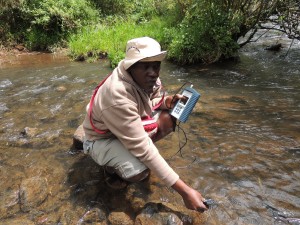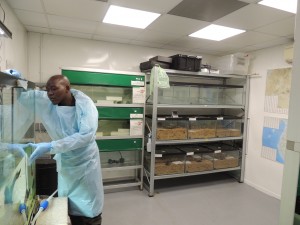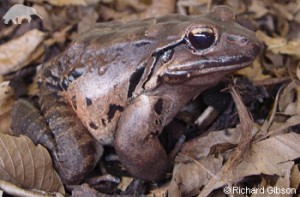What comes into your mind when you hear of a person determined to go into the wilderness to study an animal s/he has never seen? Well, that is me. I have had an undying craving to rediscover a one Du Toit’s torrent frog endemic to the Mt Elgon, Kenya and last seen in 1962. Going up and down the rivers, checking the rapids, caves by the waterfalls, rocky seeps and every possible habitat, this has been our task during amphibian surveys in the last one year.

The terrain on Mt Elgon is not easy to navigate. There are enormous cliffs stretching across vast sections of the mountain. The waters are extremely cold, and there is no option anyway but to work inside the channels. You have no idea whether it is raining upstream, which could be miles beyond the Kenyan border, then all over sudden flush floods come. Sometimes I have had pressure build up in my chest, certainly owing to anxiety – when shall I ever see this frog! An evening comes and it dawns on me that we still have not yet found the frog…….time as well as resources running out!

In the EDGE office at ZSL
2014 has really been a rewarding year for me. I was lucky to secure a chance to participate in the annual Students Conference on Conservation Science (SCCS) at Cambridge. I am indeed grateful to the organizers of SCCS for their sponsorship which included a bursary for my Internship at ZSL. The purpose of the internship was to discuss more on my project with the ZSL and EDGE experts, aiming at achieving better results during the remaining fellowship period and beyond.
My internship began on 3rd April 2014 coinciding with the time when the EDGE team was working hard towards publishing the EDGE Birds species list. I have found a very lovely team in the EDGE office. I love their commitment to duty. This I observed for myself, that during the discourse (and in a bid to beat the DL), there was great dedication and self-sacrifice, great team work, keen consultation, and love for what they were doing! I was meant to understand that the long journey began some years back but now the impact can be experienced across the globe. This has been a daunting task, a long journey began years before but the effort has now borne fruit. This is a phenomenal achievement towards global conservation of birds that are evolutionarily distinct and globally threatened.

Amphibian’s research and conservation at ZSL’s Herpetology department
In the last week of my internship, I was privileged to have hands-on experience working together with the herpetology team at ZSL. The Herpetology department is doing incredible research and conservation breeding activities in an attempt to save some of the world’s species of reptiles and amphibians which are threatened with extinction. My purpose for working in this department was to learn more on these programmes with the hope that the skills I learn would help me with our conservation initiatives for the Critically Endangered Du Toit’s torrent frog in Mt Elgon, Kenya.
During my short stay with the team, we were able to do swabbing of amphibians – screening for the Batrachochytridium which is a key threat to amphibian’s survival. It was a great opportunity for me to get acquainted with good amphibian housing, husbandry practices as well as bio-safety procedures. Among the many notable conservation breeding programmes, I was most fascinated with the successes in breeding of the Poison Dart frogs and also the Mountain Chicken frog (Leptodactylus fallax). I was involved in examination of the latter for diseases and most interestingly, the examining of these for bone formation (and other organs) before any release into the wild aimed at boosting the in situ conservation efforts. The Mountain Chicken frog is native to Dominica and Montserrat. The herpetology scientists at ZSL are breeding this species on behalf of the Dominican Republic where wild populations have significantly declined. According to IUCN, the Mountain Chickens are listed as Critically Endangered because of a drastic population decline, estimated to be more than 80% over the last ten years, inferred from the apparent disappearance of most of the population due to chytridiomycosis and volcanic eruptions. The breeding success in captivity and mitigation to Chytrid fungus threat as well as other diseases by the ZSL herpetologists is therefore a great achievement that deserves to be commended.

The lesson I learn from my involvement with the ZSL’s EDGE and Herpetology teams is that every cloud has a silver lining and good effort will always be rewarded. The whole figure may appear blurry today but tomorrow (or later) a clear picture will come into perspective. And so, I must carry on with the work on Du Toit’s torrent frog….